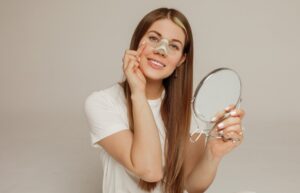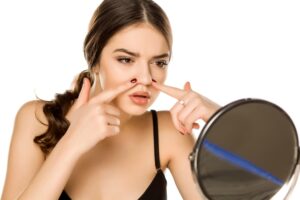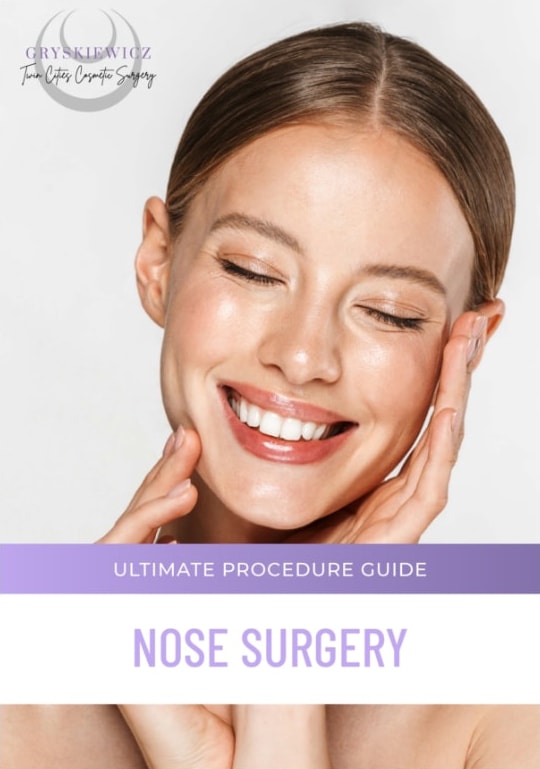How to Make Your Nose Thinner
Written By Joe Gryskiewicz, MD, FACS
Human beings are visual creatures, and we frequently form perceptions based on appearances, especially facial features, that can significantly impact our social interactions. Our fascination with facial features is deeply rooted in our psychology. Scientific research suggests that the human brain has a specialized mechanism, known as the fusiform face area (FFA), dedicated to face perception. The nose, being the central feature of our face, plays a crucial role in our perception of others and even ourselves. Cultural and societal norms further influence these perceptions, which vary significantly across different regions and societies. For example, a straight, thin nose is often considered ideal in Western societies, while broader noses are appreciated in some cultures. Moreover, studies show that individuals often attribute personality traits based on the shape and size of the nose, demonstrating the role of facial features in our social and interpersonal judgments.
Board-certified Plastic Surgeon Dr Joe Gryskiewicz specializes in nose surgery and can assist you in achieving your desired nose shape through a rhinoplasty procedure.
Facial Proportions and Beauty Standards
The science of aesthetics, particularly in relation to facial proportions, is both complex and fascinating. The concept of beauty varies across different cultures and societies, but certain universal elements, such as balance and symmetry, have been identified by scientists as key indicators of attractiveness. One mathematical principle often cited in relation to beauty is the ‘Golden Ratio’, roughly 1:1.618, which when applied to the human face, dictates the ‘ideal’ proportional relationships between various facial features, including the nose. In this context, a nose that aligns with these proportions is often deemed ‘attractive’ or ‘beautiful’. However, societal and media influences significantly impact our perception of beauty, with trends often favoring a slimmer and more refined nose shape, especially in Western societies.
Reasons to Want a Thinner Nose
 The desire for a thinner nose is often driven by a complex mix of sociocultural influences and personal perceptions. Current beauty standards, amplified by media representations and celebrity culture, often favor a slender, straight nose, especially in our part of the world. This portrayal can shape individual perceptions of attractiveness, leading some people to desire a thinner nose in pursuit of these ideals. If you feel your nose is not in harmony with the other facial features, you might seek changes to enhance your appearance. Ethnicity and cultural backgrounds also play a significant role, as individuals may wish to refine their nose’s shape while respecting their unique cultural identity.
The desire for a thinner nose is often driven by a complex mix of sociocultural influences and personal perceptions. Current beauty standards, amplified by media representations and celebrity culture, often favor a slender, straight nose, especially in our part of the world. This portrayal can shape individual perceptions of attractiveness, leading some people to desire a thinner nose in pursuit of these ideals. If you feel your nose is not in harmony with the other facial features, you might seek changes to enhance your appearance. Ethnicity and cultural backgrounds also play a significant role, as individuals may wish to refine their nose’s shape while respecting their unique cultural identity.
How Can I Make My Nose Thinner?
The most effective way to achieve a thinner nose is through rhinoplasty, a surgical procedure. Alternatively, dermal fillers can create the illusion of a thinner nose, but their results are temporary. It’s important to note that there are no scientifically proven natural methods to make your nose thinner, despite various claims found online. Makeup, however, can temporarily transform the appearance of your nose, providing a non-permanent solution.
Options to Get a Thinner Nose
-
Rhinoplasty
Rhinoplasty procedure, often known as a “nose job.” There are two main types: open rhinoplasty and closed rhinoplasty.
Let’s start with open rhinoplasty. Imagine you’re building a model house. You’d likely open up the roof to have a good look inside and have more space to work. In a similar way, in an open rhinoplasty, the surgeon makes a small cut on the strip of skin between your nostrils, known as the columella. This allows the plastic surgeon to “open” up your nose and clearly see everything inside.
This approach provides your surgeon with a direct view of the cartilage and bone structure, making it easier to make detailed changes. This is particularly useful for more complex cases. The downside? It might take you a bit longer to heal, and there might be a tiny scar (though it’s usually not noticeable).
Now, let’s talk about closed rhinoplasty. Going back to our model house example, this would be like making changes through the windows or doors without taking off the roof. In a closed rhinoplasty, the surgeon makes all the cuts inside your nose. No scars are visible after the surgery because all the work is done internally. Dr. Joe calls this a scarless rhinoplasty.
It’s often a quicker procedure with a faster healing time compared to open rhinoplasty. However, your surgeon’s view is a bit limited, so it might not be the best choice for more complicated changes.
Remember, open or closed, it’s all about picking the right tool for the job. In this case, the “right tool” depends on what changes you want to make, and your surgeon will help you decide which approach is best for your nose.
And as with any surgical procedure, there will be some recovery time. You’ll likely experience swelling and bruising, but this is normal and will gradually get better. It’s important to follow your plastic surgeon’s advice during recovery to ensure the best results from your rhinoplasty procedure.
Think of it like a renovation project for your nose. It might take a little time and cause some temporary discomfort, but the end goal is to create a look that makes you feel comfortable and confident in your own skin.
Recovery from Rhinoplasty
 Recovering from rhinoplasty usually takes a few weeks. Initially, you might have swelling, and bruising around the eyes, and minor bleeding. It’s advisable not to blow your nose for at least a week after surgery. The final shape of your nose will be apparent after it has completely healed. Remember, it takes a full year or two until you see the final results.
Recovering from rhinoplasty usually takes a few weeks. Initially, you might have swelling, and bruising around the eyes, and minor bleeding. It’s advisable not to blow your nose for at least a week after surgery. The final shape of your nose will be apparent after it has completely healed. Remember, it takes a full year or two until you see the final results. -
Non-Surgical Rhinoplasty
For those apprehensive about going under the knife, non-surgical rhinoplasty (injection rhinoplasty or medical rhinoplasty) offers an alternative. It involves the use of injectable fillers to alter the shape of the nose temporarily for up to a year or so.
Non-surgical rhinoplasty is a quick outpatient procedure where your surgeon injects dermal fillers to add volume to the nose. Your surgeon can fill depressions, smooth out sharp angles, or change the angle of the tip of the nose, restoring symmetry and making your nose appear smaller or thinner.
Recovery from Non-Surgical Rhinoplasty
The recovery time from non-surgical rhinoplasty is minimal, and patients can usually resume their daily activities immediately after the procedure. There might be some slight swelling, redness, or bruising at the injection site, but these side effects subside within a week. Remember, non-surgical rhinoplasty provides temporary results and requires periodic treatments to maintain the desired shape.
Are There Natural Ways to Reduce Nose Size?
Despite the desire for a natural and non-invasive solution to reduce nose size, there is no scientifically proven remedy to achieve this. However, several popular natural remedies are often mentioned in discussions on the topic. It is important to note that these treatments lack scientific evidence regarding their efficacy in reducing nose size.
Nose Contouring with Makeup
Nose contouring is an at-home, non-permanent method that can dramatically transform the appearance of your nose. By using contour shades and highlighters, you can create the illusion of a narrower nose. There are many tutorials available online to guide you through the process.
Remember that the effects of makeup will only last until you wash your face, but it can be a fun and temporary way to experiment with different nose shapes.
Nose Exercises
Nose exercises have been a subject of controversy, with some claiming that specific facial expressions or repetitive exercises can permanently change the shape and size of the nose. However, the truth is that nose exercises do not have any permanent effect on nasal cartilage, which is the major component of the nose. While muscles can be shaped through exercise, reshaping cartilage solely through exercise is nearly impossible.
Ice Treatment
 Applying ice to the nose can temporarily reduce swelling and restore the nose to its previous size and shape after trauma or injury. However, this method is effective only as a short-term solution for swelling caused by external factors. Ice does not alter the natural size of nasal cartilage and bones.
Applying ice to the nose can temporarily reduce swelling and restore the nose to its previous size and shape after trauma or injury. However, this method is effective only as a short-term solution for swelling caused by external factors. Ice does not alter the natural size of nasal cartilage and bones.
Toothpaste and Anti-inflammatory Substances
Recent recommendations include using toothpaste, ginger, and apple cider vinegar as remedies to reduce nose size. These techniques may provide minor relief from swelling and help the nose return to its natural size after an injury or trauma. However, like the ice treatment, they have no impact on altering the natural size of the nasal cartilage and bones. Limited evidence supports the effectiveness of these techniques.
Rhinoplasty continues to be the go-to surgical solution for people looking to decrease their nose size and enhance their face’s overall look. There aren’t any natural remedies that have been scientifically backed for minimizing nose size, but there are other methods like non-surgical rhinoplasty and contouring with makeup that can offer short-term results. Rhinoplasty is the most difficult cosmetic procedure. It’s crucial to have a chat with a competent plastic surgeon to explore the best strategies tailored to your unique situation and expected results.
FAQs about Getting a Thinner Nose
How long does the recovery process take after rhinoplasty?
The recovery process after rhinoplasty can vary, but it generally takes several months to a year for the full healing and final results to become apparent. However, your nose will appear dramatically improved when the splint is removed one week post-op. During the first week, there may be swelling, bruising, and discomfort. Over the next few months, the swelling gradually subsides, and the nose shape refines. It is important to be patient and follow up with your surgeon for regular check-ups. The final results may not be fully visible until about a year after the surgery.
Can rhinoplasty correct breathing problems?
Yes, rhinoplasty can address both cosmetic concerns and functional issues related to breathing. The procedure can improve the internal nasal structures, such as the nasal septum, to enhance airflow and alleviate breathing difficulties. It’s important to discuss any breathing concerns with your plastic surgeon during the consultation.
Are there any age restrictions for rhinoplasty?
While rhinoplasty can be performed on patients of different ages, most surgeons prefer to wait until a person’s facial growth is complete. Generally, this occurs by the early teens for females and the late teens for males. However, there may be exceptions, and it’s best to consult with a qualified surgeon to determine the most appropriate timing for rhinoplasty based on individual circumstances.
How long do the results of liquid rhinoplasty last?
The results of liquid rhinoplasty, also known as non-surgical rhinoplasty, are temporary and usually last between nine to twelve months or even longer. This timeframe can vary depending on several factors, including the individual’s metabolism, the type of dermal filler used, and the area of the nose treated. Dermal fillers used in non-surgical rhinoplasty are made of hyaluronic acid, a substance that adds volume and shape to the treated area. Over time, the body gradually breaks down and absorbs the hyaluronic acid, causing the effects of the filler to diminish.
Are there any risks or complications associated with rhinoplasty?
Rhinoplasty, like any surgery, carries risks and potential complications. These include infection, bleeding, adverse reactions to anesthesia, scarring, and the possibility of asymmetry or dissatisfaction with the aesthetic outcome. However, these complications are rare when the procedure is performed by a skilled and experienced plastic surgeon. It’s important to have open communication with your surgeon, follow pre- and post-operative instructions, and choose a qualified professional to minimize these risks.
Further Reading about Rhinoplasty with Dr. Joe
- Read Dr. Joe’s Blog about Surgery for a Smaller Nose
- Read Dr. Joe’s Blog about Best Rhinoplasty for a Bulbous Nose
- Read Dr. Joe’s Rhinoplasty Surgery Page
- Read Dr. Joe’s Blog about Different Types of Nose Shapes
- Visit our Rhinoplasty Gallery
Medical References about Rhinoplasty
- What to know about rhinoplasty – Medical News Today
- Rhinoplasty Surgery page – WebMD
- Rhinoplasty (Nose Job): Surgery, Recovery, Before & After – Cleveland Clinic
- Rhinoplasty – NCBI



